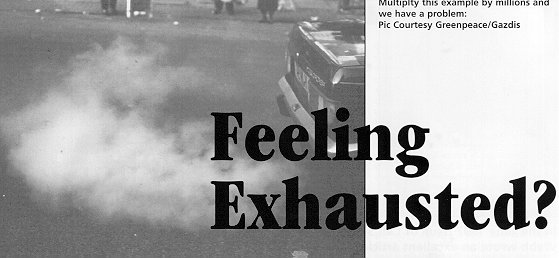
The following article was written by Steve Neville LRSC who has carried out research
into traffic pollution on behalf of Westminster City Council. It has been adapted for
publication by Joy Thompson…
|
FEELING EXHAUSTED? Imagine a normal day at work, you sit in your taxi and feel safe and warm, cocooned from the outside world. Perhaps you spend much of your time immobile together with several hundred other vehicles whose engines are running but going nowhere. Never mind, you have a tonne of steel, rubber, plastic and glass to protect you from the world outside. You may notice motorbikes, pedestrians and cyclists struggling with the same traffic you encounter. You may even have felt sorry for them from time to time breathing in the exhaust fumes, they look so vulnerable and unprotected. However, you may be feeling sorry for the wrong people. Research suggests that the enclosed environment of motor vehicles does not protect you from air pollution. In fact, pollution appears to become concentrated in vehicles and so could be affecting drivers and passengers more than anyone else. About eight years ago, I measured levels of carbon monoxide (CO) inside my car as I drove around eight major cities in Great Britain. The cities included in my study were London, Bristol, Cardiff, Manchester, Glasgow, Newcastle, Leeds and Birmingham. I found that over a period of hours as I drove in and out of polluted areas and congestion, levels of CO inside my vehicle sometimes exceeded levels set by the World Health Organisation (WHO) and the UK Air Quality Strategy. This means concentrations of CO in my vehicle reached levels which could have adverse effects on my health. MORE FUMES IN A VEHICLE THAN ON A BIKE |
the Institute for European
Environment Policy has recently been published. This confirms my own findings and
concludes that drivers and passengers are breathing in up to three times more exhaust
fumes than pedestrians and cyclists. Drivers and passengers appear to travel in the centre
of a 'tunnel' of pollution created by the vehicles in front. Pedestrians and cyclists are
subject to lower concentrations of pollution because they travel nearer the roadside at
the edge of this 'tunnel'. HEALTH EFFECTS OF INDIVIDUAL POLLUTANTS VOCS |
CARBON MONOXIDE (CO) NITROGEN DIOXIDE (N02) PARTICULATES (PM10S) |
Powered by NetXPosure |
Copyright © 1998 Dial-A-Cab Ltd, All rights reserved.